
Thunderbird ships for a rp
.
.
there base aka Tracy island/ prime island
Tracy Island is situated somewhere in a remote sector of the central Pacific Ocean, midway betwen Japan, Australia and South America
Built on an extinct volcano, this island possesses enormous lava tubes and underground cave systems that provide a natural infrastructure. There is some cutting-edge technology is in use throughout, including a team of autonomous maintenance robots. A holographic/physical-cloaking device enables the island to create its own cloud-cover... rendering it undiscoverable to any observers. Underneath the main house are vast caverns, where the family can stockpile raw materials. They can even mine and refine metal ore from their island.
A streamlined two-story villa to one's personal design, sited on an outcrop of rock overlooking a palm-fringed apron - which offered the perfect location. The décor of the main house reflects the taste in oriental design and culture. A spacious lounge forms the focus of the main building, with family bedrooms and a small laboratory workshop on the same floor - all fitted with the latest audio and visual systems, including micro-layer flat-screen TVs and total-surround audio players and speakers. There's also a family dining room, a breakfast nook and a modern kitchen fitted with the latest-model atomic cooker. From the lower floor, access can be made to a complex of leisure facilities built into the island's labyrinth of caves. A gym, shooting range, billiard room, a small cinema, a music room and an indoor pool are just a few of the amenities that the family can enjoy during moments of relaxation.
The centre of family life, accessed by a smaller reception room leading off a central hallway, the main Lounge is spacious and well-lit. Angled French windows along one wall open onto a full-length balcony, from the split-level floor space. Directly facing the main desk, to the left of the room's main entrance, visitors will see portraits of five beings in everyday casual attire. In the far corner diagonally opposite the main entrance, are the main desk and work station. Behind the desk are shelves lined with books and personal mementos, surrounding a video monitor built into a compact electronic control unit and communication post. Originally mounted on twin supports, the desk could be raised to the ceiling when not in use. Just off the kitchen is a small tropical patio, with a door leading outside the villa. The medical facility is fitted with two beds, each with the latest Auto Nurse monitors, for patients; as well as a desk to carry out medical tests.

.
.
the ships
.
Thunderbird 1 piloted by Kieron

Thunderbird 1, built by Brains and piloted by Kieron, is a variable geometry (swing wing) VTOL rocket plane belonging to International Rescue. Like Thunderbird 2, it is used for earthbound rescue missions, operating at a maximum height of 150,000 feet.
Thunderbird 1 is capable of 15,000 miles per hour, making it one of the fastest planes in the world, if not the fastest. The only known ship to be able to exceed it in terms of speed was the prototype TV-21, Jeff Tracy's first ship prior to the formation of International Rescue. The primary role of Thunderbird 1 is often to simply get to the danger zone and scout around so that a rescue operation can be planned before the equipment needed arrives via Thunderbird 2, but it'll often play a supporting role alongside the jolly green giant with its own gear and special abilities, which occasionally makes it the only Thunderbird necessary for the job.
Length/Height: 80 feet
Wingspan: 20 feet
Wingspan with wings folded out: 26 feet
Maximum speed: 15,000 mph
With a sharp red nosecone, a cylindrical silver body, and a powerful blue engine, TB1 is built for pure speed and can reach anywhere on Earth within an hour, evident from the fact it has the most number of rearward thrusters of all Thunderbirds alone. TB1 takes off from Tracy Island vertically, but shifts and stays into horizontal flight shortly after. TB1 has a high speed mode and a slow/landing speed mode. During the former, which it launches in, the small sweep wings are entirely tucked in, and the cross shaped bottom is positioned in the manner of a plus sign. When coming into land or simply when flying slower and steadier, the wings extend and the back rotates into an X. The wings must always be extended when landing horizontally, since landing legs are located within them. TB1 only lands vertically when returning to Tracy Island.
TB1 has a definite underside and topside when flying horizontally; the underside has four VTOL jets, a large glass window for the pilot, and bay doors in the midsection, while the topside just has "THUNDERBIRD" written down it, completed by the "1" painted on both sides of the blue coloured section.
The interior goes from the nosecone to the wings. The pilot's chair is located at the front (near the nosecone) where the windows are. There are no front facing windows with the aerodynamic nosecone taking up the entire front. Thunderbird 1 flies almost entirely via instrumentation provided by the forward holographic display. The windows underneath can open up, and the chair can be carried outside via a robotic arm, providing swift entrance and exit. The underside bay doors lead to the rest of the interior, where the ceiling contains a long-ranged electromagnetic cable that can have different attachments at the end such as clips, and ladders allowing swift passenger boarding. Despite being designed as a first responder and scouting craft, it has occasionally been enough to make her the only Thunderbird needed for a mission, as seen in Runaway. It also has a rescue capsule that is used to transport a single individual is seen in Brains vs Brawn but it is unknown how many capsules can be stored in Thunderbird 1.
Equipment
grapple hook: Thunderbird 1 has a grapple installed in the cargo bay. The end of it can also be swapped for a clip, like seen in the episode Runaway.
Sky pod: When dealing with an unstable aerial platform, Scott gets in close to examine the platform using the 'Skypod', a short-range flying capsule that allows him to get in close to a target where Thunderbird 1's size would be a disadvantage.
Remote Control Drones: Thunderbird 1 is equipped with several remote operated drones that can be deployed to search multiple areas or places that cannot be reached by convential means
https://youtu.be/w0ciIWeVLwM
.
Thunderbird 1 launch
https://youtu.be/S_qBvZlMaFc
.
.
Thunderbird 2 Piloted by Jonson

(info from the show)
Thunderbird 2 is a large, supersonic, VTOL freight carrying aircraft. Like the rest of the Thunderbirds, it was created by Brains and is owned by International Rescue. Thunderbird 2 is used in earth-based rescue missions, usually alongside the much faster Thunderbird 1, compared to which it is significantly slower, but has far greater functionality. Thunderbird 2 is a long range craft, capable of travelling anywhere in the world without the need to refuel. Thunderbird 2 has a maximum altitude of 100,000 feet.
TB2 is a giant, wide-body, green coloured, somewhat blocky plane with small forward-swept wings, a massive rear spoiler and large rectangular engine intakes on either side. Despite its bulky appearance and the slowest of all 4 flight-capable Thunderbirds, the two rearward engines are powerful enough to allow it to fly at supersonic speeds nonetheless. TB2 is capable of vertical take-off and landing through the use of 4 large jets tucked underneath the craft's sides, close to the intakes. The VTOL jets can tilt forwards and backwards for slow and steady flights in all directions, and are powerful enough to let TB2 lift extremely heavy objects and vehicles, having once picked up TB1 with no apparent difficulty. The wings can fold upwards when not in use, allowing for easier landings. Two means of entrance and exit can be found at the crafts front end; a manually operated hatch on top, and a platform that can be automatically lowered underneath, and both lead straight to the cockpit.
TB2 is designed as a freighter in mind, with the middle of the craft hollowed to carry one of the many modular containers carrying gear for different kinds of rescue missions. As such, it is often regarded as the 'main' Thunderbird for land and sea-based rescue missions, seen being sortied out on almost every single rescue mission that doesn't involve going to space.
One key mission ("Long Haul") saw TB2 being adapted to go into space to assist in a rescue mission on a satellite, as Thunderbird 3 was currently occupied pumping oxygen to a trapped member of the crew and couldn't be diverted to collect the necessary equipment to repair the satellite. On a later occasion ("Signals Part 2"), Virgil and Lady Penelope were able to make improvised modifications to TB2 in the field so that it could go underwater when Scott was trying to retrieve a key escape pod in Thunderbird 4.
Height: 31 feet
Height with pod lowered: 57 feet
Length: 112 feet
Wingspan: 82 feet
Wingspan with wings folded in: 56 feet
Maximum speed: 5,000 mph
Payload: 100 tons
Body weight: 406 tons
Thunderbird 2's co-pilot seat allows the craft to be piloted by someone sitting on the right.
The 6 Modules
The middle of TB2 is completely hollow, a space to be filled in by one of six cargo carrying modules carrying different types of gear. The contents can be deployed when TB2 has landed after four telescopic legs located near the VTOL jets have extended, lifting up the entire craft while leaving the module on the ground, whereupon their drawbridge-like doors can open. The underside of the modules can also be opened, mostly when TB2 is required to launch its electromagnetic cables while still having the modules attached, or simply to drop any equipment or vehicle stored inside, most of the time being pods in flight-capable configurations, while TB2 is airborne. The underside of the modules have wheels, which is hardly visible most of the time, attached, allowing TB2 to seemingly slide along its designated runway in Tracy Island.
Module 1: Module 1 specializes in carrying fire-fighting equipment. It is shown to include a pair of extinguisher nozzles which can be deployed on the underside, and a low-frequency fire suppression system on the topside, which are essentially speakers and subwoofers, thus oddly enabling the fire fighting equipment to play music.
Module 2: The most commonly used Module, which is fitting, as it shares the same number as Thunderbird 2. It is a general use module without any specialisation, carrying the Pods, which are two durable chassis that can be outfitted into various kinds of smaller rescue vehicles using a variety of attachments. The attachments are kept in metallic crates stored on the walls of Module 2, and are brought down and attached into the body of the Pod via robotic arms.
Module 2 also has, in between the two bay doors, a pair of electromagnetic cables. They are designed to point down and be used once the first door opens.
Module 3: Home of the large electromagnetic grabs. The grabs are used to lift up and move the largest and heaviest of objects. The tips of the 4 fingers are electromagnetic, which allowed them to rip off a roof in The Hexpert. A row of seats stored on Module 3 are able to be picked up by the grabs and lowered, in order to collect people. Module 3 has also carried the RAD, and it was able to carry Thunderbird 1 using four electromagnetic cables between the two layers of bay doors, like Module 2.
Module 4:Designed specifically for aquatic rescue missions and carrying Thunderbird 4, which can exit once the door of the Module opens via a metallic slide that extends out in a telescopic manner. The module is the only one shown so far to float on water; a feature not known currently to be unique to Module 4 or shared among all modules. Thunderbird 4 is retrieved through the use of a magnetic cable behind the slide that shoots out to hit the rear of the sub and carry it back up. Like Module 2, Module 4 also has bay doors, allowing Thunderbird 4 to be gently lowered down by the magnetic cable, which was seen in Heavy Metal. The module is also equipped with the Remote Airbag Pods, which were used in Heist Society. It is equipped with a shower room for TB2's occupants, mainly Gordon, to freshen up; yet another feature not known to be unique to Module 4 or shared by all Modules. It is also capable of carrying any additional Pods that are needed as well when the situation requires it as seen in Power Play. Like Module 3, it consists of large electromagnetic grabs, as seen in Signals Part 2 as well as a Row of Seats to collect people as seen in Falling Skies.
Module 5: Module 5 is made specifically for carrying fuel for other vehicles and vessels. A fuel line can be extended when the underside bay doors open, allowing refuelling for or pumping out of other vessels and vehicles. As expected, the capacity is very limited. The equipment can also be used to store and supply other liquids such as a concrete sealant. The module, just like modules 3 and 4, also contains seats that can be lowered to collect people.
Module 6 :Like Module 4, Module 6 is capable of carrying Thunderbird 4, but it is used in rare occasions of Thunderbird 2 having to travel into space.
Equipment
Jaws Of Life: The Jaws Of Life (referred to as the Power Suit) is Virgil Tracy's signature rescue exo-suit equipment, seen in many episodes of Thunderbirds Are Go!. It is a robotic exoskeleton that covers the upper body, the spine and the legs. They greatly enhance the strength of the user, allowing them to effortlessly pick up heavy items at the scale of tons--weight too heavy to be lifted by even the strongest human beings. They also aid in scaling various structures, and can also allow one to safely pick up items of extreme temperatures harmlessly.
The hands consist of a strong crab-like pincer claw on the right that can crush rock and metal, and a telescopic three fingered claw on the left for more precise and delicate grip. The device has a black and yellow colour scheme, resembling the pattern on typical barricade tape.
There are many Power Suits, Not only did Thunderbird 2 store one inside Module 2 and 3, but one could also be found stored within the Explorer, there is also a variant seen in Inferno configured specifically for fire-related rescues.
.
Electromagnetic Cables: Thunderbird 2 has four electromagnetic cables. They end with circular clamps and can be fired down at high speed. However, since they are all located within the hollow area for the Modules, they can only be used when the Module is detached, and they therefore provide the additional job of recollecting a dropped module while the ship is airborne, which is how Module 4 is retrieved while floating in water, or at times, partially deploy the Modules, allowing the front bay door to be opened without having to drop the Module out entirely. The cables have an unspecified, but incredible length, and Thunderbird 2 can use them to lift 100 tons worth of weight.
Nosecone Grabs: Like the set that are stored in Module 3, Thunderbird 2 also has another set of grabs stored in its nosecone. They are the same design as the ones in Module 3. They even have their own row of seats to pick up and drop off people with.
Grapple Launchers: Four grappling hooks are outfitted on the walls of the module compartment, which can only be deployed when Thunderbird 2 has deployed its module. It is only seen use once so far.
Laser: A laser is located at the front of Thunderbird 2. It has been seen cutting a chunk things as to cut a way for some one to get in or out aka it a cutting laser
Drop-down: Turret A retractable launcher of sorts housed in a compartment below the cockpit and in front of the module. It is shown to be capable of launching magnetic clamps, fire retardant grenades, avalanche sensors, and releasing droplets of water to create clouds.
https://youtu.be/DkQ60y-o6QM
.
Thunderbird 2 take off
https://youtu.be/auKeSRLM1kw
.
.
Thunderbird 3 Piloted By Sarah
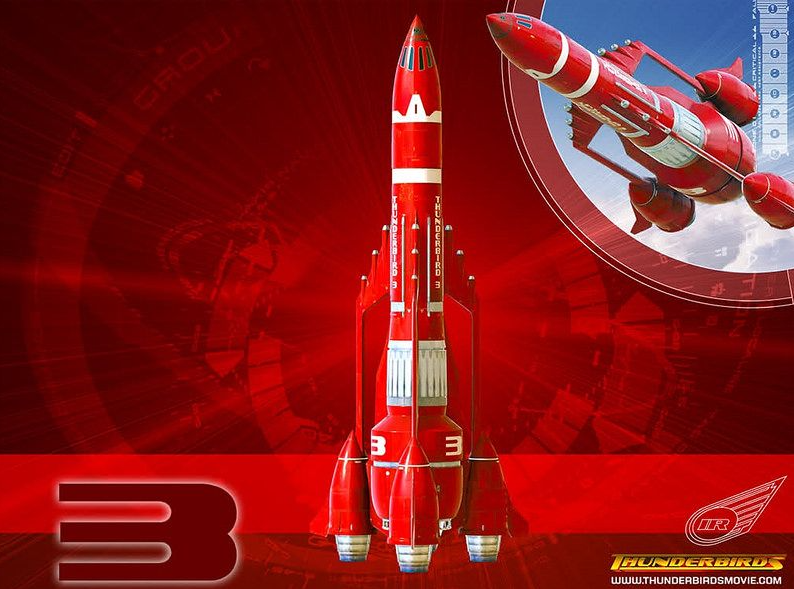
( info from the show it self)
Thunderbird 3 is a giant SSTO (Single Stage to Orbit) space rocket that is revolutionary in terms of speed, functionality and reusability. A real red hot rod, she was created by Brains and is owned by International Rescue. Her existential purpose is to save the lives of people who are in mortal danger outside of the Earth's atmosphere, though she has been used unconventionally several times.
Although capable of agile atmospheric flight (as seen in Skyhook & Falling Skies) and handles well in situations where gravity is significant thanks to its powerful thrusters, TB3 lacks wings to generate lift and is primarily designed for space rescue missions, usually only flying straight upwards to space after launching. It can move very freely in space using vernier thrusters built around its whole body to perform delicate maneuvers. The engine array at the base of the rocket includes an incredibly powerful central ion engine for extremely long distance space travel, and three rocket engines surrounding it. Three grapple arms connect the middle of the ship to the three rocket engines, which can be deployed for various uses. The cavities where the arms sit has nozzles, allowing the engines to fire frontward when the arms are deployed.
TB3 has highly advanced heat and radiation shielding, allowing it to get very close to the sun without suffering meltdown in its systems. Its ion engines allow travel to other large nearby celestial bodies in a relatively short time. The rocket can travel to the sun in a matter of hours and Jupiter, within a few days; both of which could take months when done conventionally. While TB3 has large fuel reserves, the amount of fuel carried is mission-specific, as seen in Slingshot, where TB3 almost ran out of fuel around the sun forcing Alan to slingshot TB3 around the sun to get back to Earth, while it never had problems traveling to and from Jupiter in Deep Search.
TB3 sports a cargo bay above the engines that can carry and assemble one Pod that is specialized for outer space rescue. While the cargo bay is large enough to carry more than a dozen people even with the Pod in it, it is ill-suited to doing so as it has only large bay doors instead of airlocks.The cockpit is located in the upper-middle of the rocket's body and it has 4 seats, making it the largest cockpit among all the Thunderbirds. Windows form a ring all around the fuselage, and the cockpit can rotate so that Alan can see all around the outside. This cockpit is home to an airlock exit as well as the Space Surfboard.
Length/Height: 179 feet
Wingspan: 70 feet
Maximum Acceleration: 10G
Drive system: Ion-drive particle accelerator
Launch system: Hybrid electromagnetic/rocket motor
Pod Assembly
Just like Thunderbird 2, Thunderbird 3 has a Pod inside its cargo bay, but unlike Thunderbird 2, there is only one Pod. This particular Pod looks identical, save for the circular magnetic dock on top of it, but it is specialized for outer space rescues. Its various attachments are unique, and are stored in red crates, ready to be picked up and fastened on by the robotic arms of the bay. Thunderbird 4 can also be carried and modified within the cargo bay of Thunderbird 3.
As of season 3, the pod in Thunderbird 3 is changed to one red in color and dubbed "space pod". How this particular version of the pod differs from the standard ones is currently unknown.
.
Equipment
Nose Cone Drill: Thunderbird 3 has a large drill stored in its nose cone, which provides Thunderbird 3 with a strong grip on unstable structures; such as meteors and comets. As seen Life Signs, the drill part can be extended very far from the main body, connected through a shaft that runs the length of the rocket. Due to its size and main purpose as essentially a stabilizer instead of a dedicated tunneling equipment, it is ill-suited for precision drilling.
Grapple Arms: Thunderbird 3 has three grapple arms used for latching onto structures in space such as satellites and debris. Usually, the arms are attached to the three booster engines of Thunderbird 3, but when in use, they fold out from the engines and extend forwards. These arms are also used to help Thunderbird 3 dock with Thunderbird 5. The tip of each arm contains one tow cable used for stabilization during landing. One one occasion, Thunderbird 3's grappling arms and central body were modified into the Maximum Max, allowing her to go toe to toe with the Mechanic's Deep Ocean Surveyor in a zero-gravity fight. Instead of grapple arms, they were replaced with a robotic hand, a buzz saw and a plasma cutter.
Electromagnetic Cables: Thunderbird 3 also has a set of electromagnetic cables stored in the tips of the Grapple Arms, they are used for grabbing multiple objects, each Grapple Arm contains several cables, making Thunderbird 3 the Thunderbird craft with the most number of electromagnetic cables.
https://youtu.be/5Z1oaA2q_Yo
.
Thunderbird 3 take off
https://youtu.be/JEecxr-9AKQ
.
.
Thunderbird 4 piloted by Apps

( info from the show it self)
Thunderbird 4 is International Rescue's technologically advanced submarine, with a maximum operating depth of 30,000 feet. Though the tiniest of the Thunderbirds, she makes up for it by being the only one who can operate underwater and is well equipped to do so. She is used for saving innocent lives all around the globe in water based areas such as oceans and rivers.
TB4 is the smallest Thunderbird of them all and one that is designed to withstand immense deep sea pressures; this helps grant its immense durability and capacity to explore undersea caves, but it also means it is far from convenient enough for the yellow submarine to go to the danger zone by itself, due to limited range, low speed, and complete inability to travel unless submerged underwater. Thunderbird 4 is therefore airlifted to the danger zone aboard Module 4, one of the six Modules that makes up the center of the supersonic Thunderbird 2. Should the latter vehicle be unavailable, Thunderbird 4 can leave Tracy Island alone for a mission that is close enough.
Thunderbird 4 can be entered via an underside hatch, which leads straight to the little cockpit (designed for Gordon to control, however it has managed to squish three other people into its small space - presumed standing room only (as seen in Deep Search), and a door at the back where rescued people and equipment can be put. Bright lights emit from the very front of the vehicle, allowing Gordon to see in the deepest and darkest of waters. Thunderbird 4 has many small windows on the sides and underneath the cockpit, and even the backdoor has transparent surfaces, further adding to the freedom of exploration. Thunderbird 4 has a flexible fin and two small engines at the back which allow for surprising speed and agility, even though it is still vital for Thunderbird 2 to carry it wherever it needs to go. Where there's Thunderbird 4, there's usually Thunderbird 2.
Height: 10 feet
Length: 32 feet
Length with arms: 34 feet
Width: 15 feet
Cruising speed: 184 m.p.h
Maximum speed: 287 m.p.h
Equipment
Robotic Arms: TB4 has two robotic arms that are tucked away on the underside. They swing out when in use, and Gordon controls them directly while looking through the transparent floor to see what he is doing. The left arm ends with a pincer claw, while the right arm can either end with another claw or a plasma cutter.
Torpedo Launchers: Located within the side protrusions are torpedoes used for demolition. They also have homing properties, allowing them to hit home on other machines and vehicles.
Harpoon Launchers: These can be found on the lower sides of TB4, close to the Robotic Arms. These harpoons, attached to cables like a grapple gun, can be fired forward quick enough to penetrate rock.
Dry Tubes: The name given to two evacuation pods contained within the same protrusions that store the torpedoes. Fired from the rear, they float swiftly to the surface of the water upon being released. They are big enough to contain one person each, unless perhaps if that person is too tall and/or fat.
Remote Airbag Pods: First seen in Chaos Part 1 this is the name given to two large pods that used to balance and raise large platforms or vechiles that have been submerged for various reasons. It is stored in the same protusions that stroe the torpedeos and the dry tubes. They are launced from the front of the ship and the ballons can be quickly deployed to raise the object in question.
https://youtu.be/NqSycngpSv8
Thunderbird 4 launch
https://youtu.be/8mr0bP1Jdqo
https://youtu.be/2SubYfKe1D4
.
Thunderbird 5 and is Piloted/ run by Lily

( info from the show it self)
thunderbird 5 is International Rescue's monitoring satellite space station, moored in a geostationary orbit 22,400 miles above the Pacific Ocean, directly above Tracy Island. Manned by John Tracy and EOS, it has two major roles: the first is to monitor the planet for potential disasters and receive distress calls when these arise, and as such, TB5 is equipped to scan the planet's surface in real time and listen-in on radio chatter regardless of language and location
TB5's utility does not end once a rescue is set in motion, since the satellite's second role is to provide oversight and technical assistance during operations, hacking into and taking control of data networks and their stored information, vehicles and other machinery involved in or vital to the rescue. It also serves as logistical support with John and EOS pulling out whatever information or contact field assistance related to the current mission.
To this end, TB5 is equipped with powerful solar-powered supercomputers with holographic interfaces supplemented by EOS' own advanced capabilities.
The most unusual and unique Thunderbird, TB5 is not a hands-on rescue machine as a matter of routine, but is nonetheless one of International Rescue's, if not Earth's, most useful and powerful machines. TB5, unlike her sisters, was not designed and built for direct participation in rescues, so when she is called on to do just that, it is often a sign of desperation and just how bad the situation has gotten.
Though not a vehicle in the conventional sense, TB5 can, like many other satellites and space stations, move under its own power. Thrusters allow TB5 to raise or lower its orbit and then resettle into a geostationary situation behind or ahead of its normal mooring point above Tracy Island, allowing John Tracy to better observe a particular point of Earth. Smaller RCS jets allow the satellite to alter its attitude or to move to any point above the Earth.
TB5 is, however, typically in a geostationary orbit directly above Tracy Island to facilitate the best contact with International Rescue's headquarters, and thus it primarily acts as a housing for the powerful digital technology necessary for International Rescue to even function as a lifesaving organisation.
While the full extent of TB5's abilities is unknown, it is clear that it can access the Internet (or 2060's equivalent), digital archives and communications and affect machinery remotely. Its sensor arrays are powerful enough to allow the satellite to receive distress calls from as far as Jupiter. On certain occasions EOS will caution that such actions are violations of one or more codes or laws, and it is a capability open to abuse in the wrong hands. However, TB5 is only ever shown to use such abilities if the outcome saves lives. As such, TB5's systems are never shown to disrespect day-to-day privacy.
The central structure of TB5 is shaped rather like a microphone. Around what would be the "grill" is a toroidal structure containing most of the station's rooms and facilities. This ring spins around in order to generate artificial gravity, explaining how John is able to remain in space for extended periods without suffering the musculoskeletal degradation that can be caused by extended spaceflight. For unexplained reasons, the ring can rotate at a much faster speed than is needed to generate 1G of gravitational force, allowing it to easily go above 25g, and EOS, while hostile, abuses this facility to subject John to extreme G-forces in an attempt to kill him.
Space Elevator and TB3 Docking Port
The outside of the ring is also the place to look for Thunderbird 5's Space Elevator, allowing John to visit Tracy Island at will provided TB5 is in geostationary orbit above the island. This means that the satellite is equipped with (and can store) at least 22,500 miles of cable. EOS comments that this cable is incredibly thin, though John expresses faith in its safety given Brains' tendency to over-engineer everything he designs to ensure near-absolute safety. It is likely, within the 2060 context, that the cable is some form of carbon nano-wire or some material of similar traits or strengths.
Thunderbird 3 is also capable of travelling to and docking with Thunderbird 5, with the TB3 dock at the center of the gravity ring. Three secondary docking ports allow TB3's arms to secure the ship in place more firmly. Besides an attempted docking during the EOS incident, Alan took Gordon up to TB5 for monitor duty while John was away with Lady Penelope in The Man From TB5 even though it is still unknown how the crew of TB3 get into TB5.
The elevator is surrounded by several small boosters and has a claw on the end, allowing it to directly interact with large objects in space (or far down below on Earth) with precision should it ever need to. While its primary purpose is to connect the satellite with Tracy Island, allowing John to easily travel to and from Earth as well as deliver supplies to TB5, it has seen being used for rescuing a weather station and dismantling the Hood's hubship - something it is not designed to do but performed adequately nonetheless - a notable example of Brains' tendency to over-engineering.
Space Pod
Thunderbird 5 has a variant of the multi-function Pod system seen in Thunderbird 2 and in a more limited fashion on board Thunderbird 3. First seen in just before the invasion of Tracy Island by the Hood, it is coloured grey instead of yellow. To date, John has only performed one known mission in the pod, namely to fix the Global Flood Control Network's satellite after it went offline (which turned out to be an intentional false alarm by The Hood). Unlike other Pods, TB5's is used in an upright position, equipped with two flexible arms on the sides and two rocket boosters on the back.
It is unknown if Thunderbird 5's Pod has other interchangeable components like the Pods carried by Thunderbirds 2 and 3.
Exopod
In Ghost Ship, TB5 is revealed to have been upgraded with a new Exopod system. This is a yellow exoskeletal suit assembled by EOS and TB5's systems onto John's spacesuit. It is equipped with a powerful jetpack that, as a minimum, can carry John from geostationary orbit to the L1-lagrangian point between Earth and the moon in a very short space of time. With the Exopod, John can carry out small scale rescues in and above Earth orbit without the need for TB3 to launch.
Remote Operation Probes
At times where John would need to assess a developing situation without dispatching any of the others he can launch a small probe from the cargo bay to travel to a designated area. This was first seen in the episode when he used it to search a area in the Aegean Sea for possible signs of a seaquake. It is currently unknown how many probes Thunderbird 5 has at it's disposal.
Height: 112 feet
Length: 177 feet
Wingspan: 80 feet
https://youtu.be/nIyrsSRf900
.
Thunderbird Shadow
Thunderbird 5 and is Piloted hawk

Thunderbird S, with "S" standing for "Shadow", is International Rescue's stealth aircraft, piloted by Hawk
Although considered an official Thunderbird, TBS is not equipped, or often used, for rescue missions like the main five. Instead, TBS is used for bringing criminals who cause disasters to justice and for maintaining the security of International Rescue's agents, equipment, and island base. It will often accompany Thunderbird 1 and 2 to the danger zone if the forces of evil are expected to be there waiting for them, or when they simply need an extra pair of wings.
Abilities: TBS was designed specifically for stealth capabilities, and can fly extremely quietly with incredible agility. Designed and built borrowing designs of combat aircraft, and equipped with vernier nozzles on both the topside and underside of its thrusters, Thunderbird Shadow is the most manoeuvrable and agile of all the Thunderbirds; fully capable of dog fights despite being a rescue vessel. Its ability to seemingly appear and disappear like a shadow has led to the craft being aptly named "Thunderbird Shadow". Its instruments include a light/optic sensor and multi-purpose launchers. The cockpit is actually a motorbike, and can be lowered from the ship belly to be dropped off to the ground in situations where aerial pursuit isn't practical, while remaining in remote control with the main 'body'. True to its name and dedication to stealth, TBS is equipped with two underside claws instead of conventional landing gear, allowing to cling to walls and ceilings, or underneath other aircraft. Thunderbird Shadow also carries built-in cloaking technology, allowing it to become completely invisible both to the naked eye and on radar.
Thunderbird Shadow's engines are upgraded, allowing it to carry one of Thunderbird 2's modules to a danger zone in order to deliver new equipment in the event that the contents of the original module were inadequate for an escalating rescue situation.
Specifications
Length: 52 feet
Height: 6.1 feet
Wingspan: 26 feet
Cruising speed: 12'123 m.p.h
Maximum speed: 14:789 m.p.h
Equipment
Shadow Bike: The cockpit of Thunderbird S is a motorbike which can be deployed to the ground from the craft's fuselage when aerial pursuit is not practical, such as when Kayo needs to chase down a target.
Grappling Claws: Thunderbird Shadow can cling onto walls, ceilings and other surfaces using its grappling claws.
Electromagnetic Cables: Thunderbird Shadow has electromagnetic cables. When Brains upgraded the engines in Power Play, the craft was able to carry one of Thunderbird 2's Modules with them.
Optical Camouflage (Cloaking Mode): Also known as Stealth Mode, Thunderbird S can become invisible to the naked eye and on a radar at the flick of a switch.
Electronic Control Discs: It is shown that if even one control disc is attached to a vehicle, Thunderbird S can take control of it, so long as they are within effective range.
Take off ( sadly it only one i can find is the one with well when they all take off)
https://youtu.be/NroXrASMa4o
.
pods
Pods are small vehicles used by International Rescue that are built with more specific purposes than the Thunderbirds.
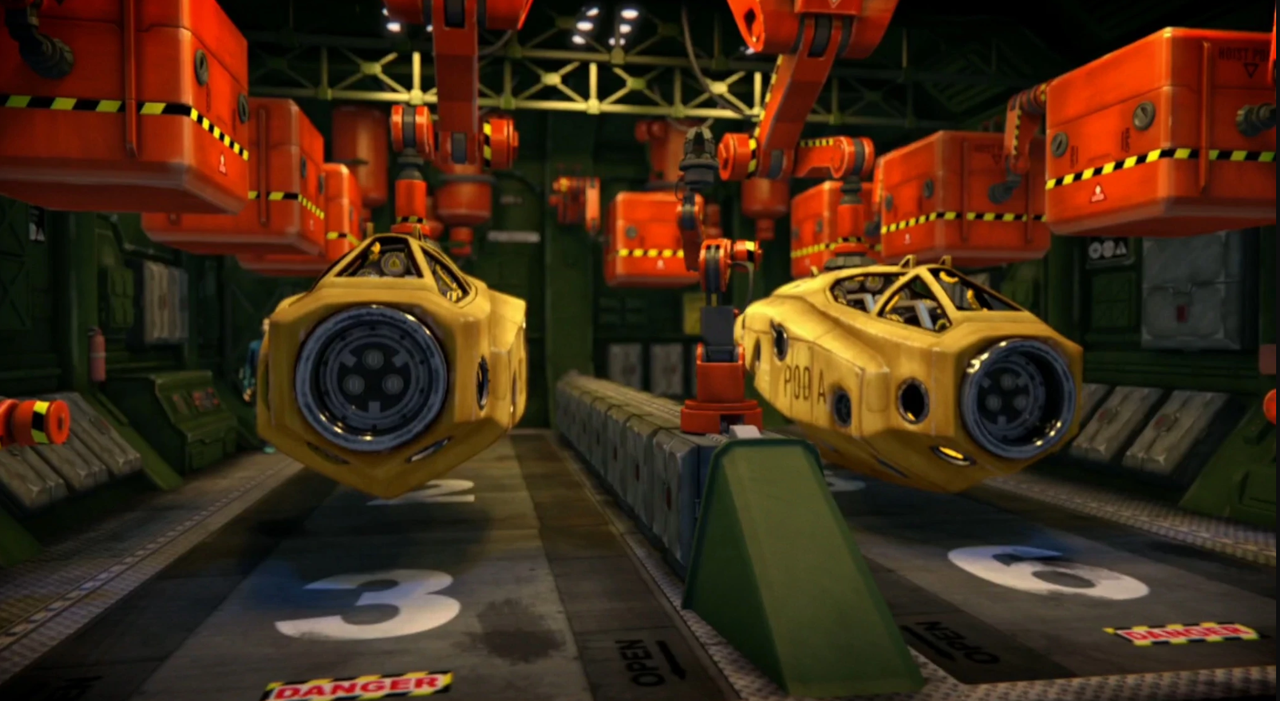
.
.
There are at least five in total and two carried by Thunderbird 2 within Module 2 and 3 (can be stored in other Modules) one for the cargo bay of Thunderbird 3
While on-board Thunderbirds 2 and 3, robotic arms customize their appearance and abilities by taking off and attaching on various tools and wheels (or other means of mobility) so that they can "become" different rescue vehicles for different uses. These combinations, all uniquely named, tend to have one form, but some may also use different attachments if they require the abilities they grant for a rescue mission. Thunderbird 2 and 3 may also have their own version of the same vehicle concept.
Without attachments, Pods are a rough cylindrical shape and, They can be entered from above by opening the glass roof. Their interior is very small and contains just two seats; one in the front for the driver, and one passenger seat in the back that is big enough to be inconveniently shared by another. They also have on-board computers capable of both taking commands without a driver required and giving commands to a Thunderbird craft. However, as of season 3, the pods used from Thunderbird 2 are green, the pod in Thunderbird 3 is Red a , making the pods the same colour as the Thunderbird that they are associated with.
they have a Height: 3 feet, a Length: 10 feet and a Width: 3.2 feet
.
Two Pods are usually contained inside Module 2, and they can be built to be two separate vehicles, or two copies of the same. These Pods contain a Power Suit in an underside compartment, and many of the vehicle combinations have both a land based and air based version of themselves.
.
The Mole
The Mole is a tunnelling machine that uses a large drill on the front, tracks at the sides, and even a jet at the back to thrust into the hardest of rock and reach those in need of help underground.

.
The Bulldozer
The Bulldozer is a heavy-duty debris-clearance vehicle armed with a large shield on the front
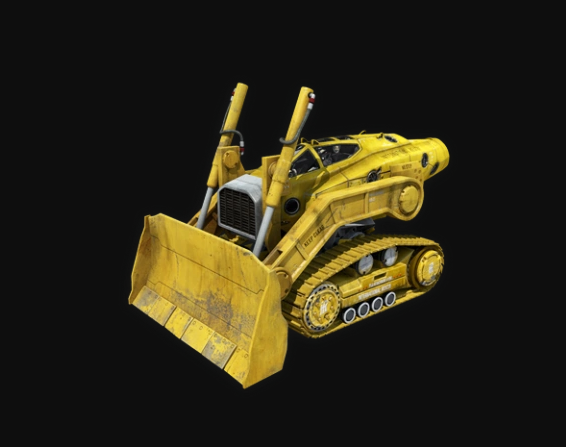
.
.
The Explorer
The Explorer is built for safely traveling through vertical tunnels and across all manner of terrain. It is notable for possessing a large variety of possible attachments for this purpose, making it look completely different depending on which episode it appears in.

.
The Elevator Cars
The Elevator Cars are equipped with large, shock absorbing platforms on their roofs. They are used to support and lift great weight and to provide planes with safe landings, although they were nearly crushed when they acted as landing gear for the Fireflash as the aircraft was too heavy for them.
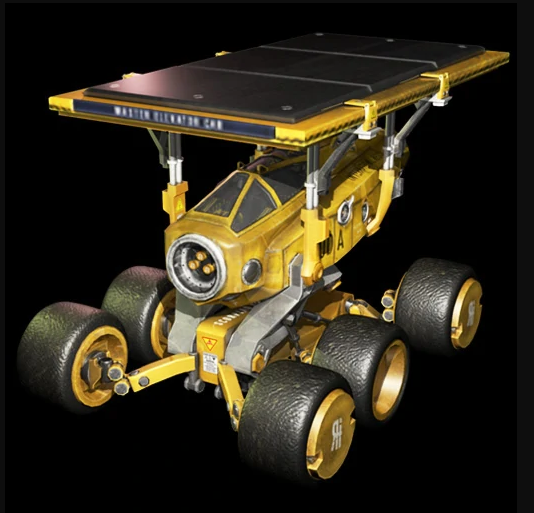
.
The Helipod
The Helipod is an air-based repairment vehicle. It's equipped with four enclosed rotors on its sides for swift yet steady flight, an electromagnetic cable on the side, and a flexible robotic arm at the front end. It can be used for heavy lifting and for fixing airborne machinery. It's also known as the 'Aeronautical Repair Pod'.
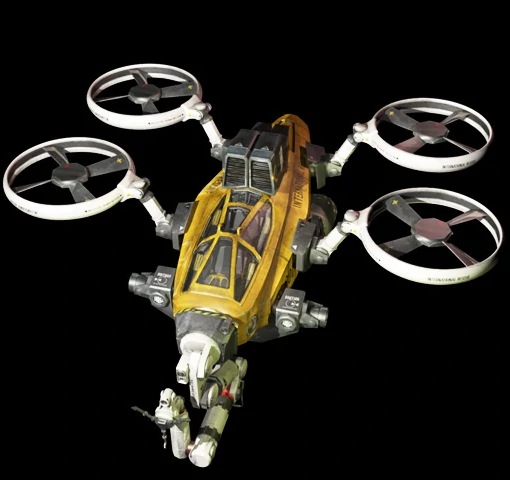
.
The Gecko Pod
The Gecko Pod is a land-based repairment vehicle. It sports four (or six) legs that allow it to climb vertical surfaces, and uses small underside arms to fix damages. This combo was also called the 'Repair Pod' by Gordon in Weather or Not.
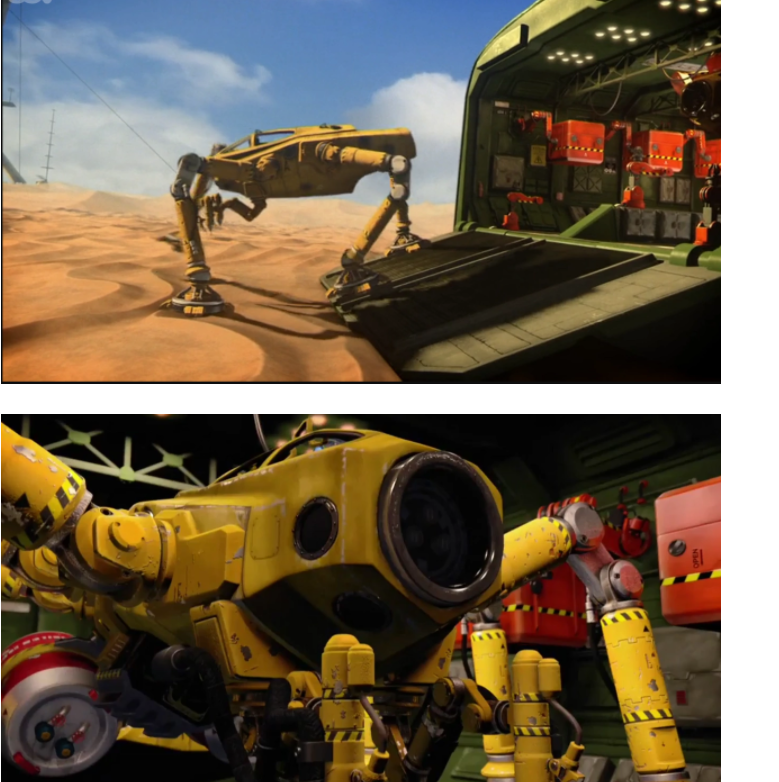
.
The Foam Stabilization Pod
The Foam Stabilization Pod has the ability to shoot a powerful adhesive onto structures which are about to collapse or are broken. It uses two foam mounted guns on its side to shoot the substance and contains it with four silos at the rear. It has been built with both rotors and caterpillar tracks, for use in the air and on land (the foam works in water as well, seen in Power Play).

.
The Mountain Pod
( no info)

.
The Submarine Pods
The Submarine Pods consist of two underwater vehicles with aqua-jets and two robotic arms; they are essentially back-up vehicles for Thunderbird 4 if the former is either out of action or undergoing repairs.

.
The Sherpa Pod
The Sherpa Pod is like the Mole pod, but built with snow in mind. It has a 'heatbank' on its front with tracks at its sides, which enables it to dig very deep inside avalanches. Also, like the Mole pod, it has tracks to carry it to its destination.
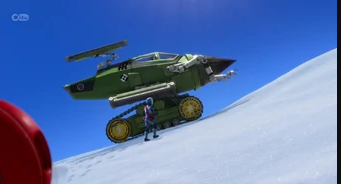
.
The Dragonfly Pod
The Dragonfly Pod is a mechanical version of a dragonfly, which enables it to fly into much smaller spaces compared to Thunderbird 2's enormous wing-span. It also capable of flying underground.

.
Thunderbird 3's cargo bay carries one Pod, and it can fly through space using multiple jets fastened to its body, but whether or not it can be driven on the surfaces of planets and moons remains unrevealed.
.
The Rescue Pod
The Rescue Pod sports a circular docking mechanism on the roof, making it useful for evacuating people from a spaceship and taking them to Thunderbird 3. It can also be equipped with a front-mounted robotic arm that can be used for welding.
and
The Explorer
The space variation of the Explorer is equipped with the Portable Debris Defence Module, which is a laser cannon powerful enough to decimate meteoroids, allowing it to explore extremely hazardous areas.

.
.
https://youtu.be/gDKP_N37OAE
https://youtu.be/6y2hFqgtjLk
https://youtu.be/3xIDE7poU0A
https://youtu.be/SlMnC68xh64
https://youtu.be/VPjGqJBBrow
https://youtu.be/bXFiLHYMFag
https://youtu.be/wz-PEg5GY9w
https://youtu.be/YcqMxuzy9ks
https://youtu.be/PhuARG1XNnQ
https://youtu.be/uldnRxNrx0Q
https://youtu.be/_59itAEXo9s
https://youtu.be/ifWePC8U3k8
https://youtu.be/qgZXMAistZ8
https://youtu.be/QsrwuykG_mw
https://youtu.be/FZi2EadeS2A
Bạn đang đọc truyện trên: Truyen247.Pro